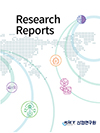Research Reports

Companies and governments in major countries such as the U.S., Germany, and Japan are investing competitively in the growing global new industry market to lead new growth engines in response to the new convergence era or the fourth industrial revolution. Major global companies are leading the market by releasing new convergence products and services based on core platforms in major new industries. In particular, China’s rapid development, which was considered a latecomer, is most prominent.
The Korean government and companies are also actively responding to the changes in the global paradigm, but has yet to stand out in the global market. In this regard, it is urgent imperative to re-examine domestic growth conditions for creating new industries and sustainable growth, and to establish corresponding policy strategies.
Based on this background, this study examines the growth potential and problems by analyzing the domestic and foreign status and domestic growth capabilities of the promising new industry which is emerging as a new growth engine in the fourth Industrial Revolution or the new convergence ear, and seek for the development position and strategies to create new industries in the future.
In this regard, this study develops four evaluation frames of innovation factors to diagnose and evaluate the growth capability for creating new industries in Korea in response to the new convergence era based on various theoretical discussion on the development conditions of the new industry and the development model. We derive four innovation factors such as ‘market demand’, ‘innovative resource’, ‘foundation for innovative growth’ and ‘activity for securing innovative capabilities’, and evaluate growth capabilities of nine new industries in Korea. In addition to the analysis using available quantitative indicators, the study also uses the results of a survey of major companies and experts in nine new industries. This study analyzes nine new industries, including ‘Intelligent Semiconductor’, ‘Next-generation display’, ‘Rechargeable battery’, ‘Artificial intelligence’, ‘Realistic contents’, ‘IoT Home appliance’, ‘Intelligent robot’, ‘Bio-health’, and ‘Self-driving car’.
According to a result of comprehensive evaluation of nine new industries in Korea(5-point scale), it is estimated that innovation capability is generally insufficient. Next-generation display was the highest at 3.13, followed by rechargeable battery(2.93) and realistic contents(2.87). Bio-health and intelligent semiconductor were lower at 2.21 and 2.27 respectively. Meanwhile, the biggest common weaknesses and threats of the nine new industries are the weakness of the industrial ecosystem and rapid growth of China, which is urgently required for supplementation and countermeasures.
In order to promote the development of new industries, innovative activities led by private sectors are needed. However, since the innovative growth capability of the new industry is evaluated to be weak, it cannot be left entirely on private sectors. Considering the nature of the new industry, which is in the beginning stage, it is necessary to create conditions in accordance with the new changes and a certain level of government role is required for the prime of investment promotion and innovative growth.
As a result of comprehensive analysis of growth capability, strength and weakness, and development position for nine new industries, policy tasks are largely summarized following three areas: technology development (basic and source R&D), strengthening of industrial ecosystem (advancement of forward and backward industries, support of SMEs, activation of business start-up), support for commercialization (demonstration project, certification·standard, public purchase), expansion of foundation for innovative growth(Human Resource Development, Institutional and Regulatory Improvement, etc.).
The policy priorities for the nine new industries is analyzed that the policy demand for supporting ‘basic and source technology’ and ‘commercialization technology’ is the highest overall. ‘Basic and source R & D’ has a relatively high priority in bio-health and artificial intelligence, ‘application and commercialization R&D’ in realistic contents, IoT home appliance and intelligent robot. Since nine new industries are located between market entry and early growth stage, policy demand for ‘commercialization support’ is found to be the second highest priority. These industries mainly include intelligent robot, self-driving cars, and realistic contents. The third priority is the policy for ‘promoting forward and backward industrial fields’ such as materials and equipment. Rechargeable battery and next-generation display correspond the third highest policy priority, and these industries require for strengthening the competence of backward industries such as core material and equipment. The rest of policy priorities are high in the order of institutional and regulatory improvement, strengthening of SMEs and business start-up, and human resource development. These support polices for nine new industries should be strategically implemented according to policy priories, considering the results of growth capability analysis and evaluation, rather than uniformly pursuing them.

The works on this page are licensed for fair use under the provisions of the Korea Open Government License. See kogl.or.kr for more information.
Please enter the security text below
to prevent email collection
Please check the information of the person in charge.
연구과제 제안이 접수되었습니다.
신청이 접수되었습니다.


View Summary
코로나19 발생 이후 대부분의 고용 관심사가 항공 및 여행서비스, 음식·숙박 서비스 등 주로 서비스 업종에 집중된 상황에서 본 연구는 최근 그 중요성이 강조되고 있는 제조업의 고용변화를 살펴보았다. 분석에 따르면, 코로나19 이후 제조업 고용은 비교적 큰 충격 없이 빠르게 회복하는 모습을 보이고 있다. 제조업 고용은 서비스업에 비해 큰 충격 없이 유지되고 있고, 코로나19 직후 2020년 상반기에 약간 하락하였지만 하반기부터 회복 추세를 보이고 있으며, OECD 주요국의 제조업과 비교하여도 일본과 함께 고용 충격이 비교적 작게 나타나고 있다. 그러나 전반적으로 양호한 고용 성적에도 불구하고 제조업 내 특성 별로는 차이가 나타나는 것으로 보인다. 종사상 지위 별로 보면, 임시·일용직, 고용원이 있는 자영업자에서 고용 충격이 상대적으로 크게 나타났고, 상용직과 고용원이 없는 자영업자는 큰 충격이 없는 것으로 나타났다. 제조업 규모별로는 300인 이상의 경우 코로나 발생 초기 약간의 충격 이후 고용이 빠르게 반등하면서 코로나 이전보다 고용이 더 증가한 반면, 이보다 작은 규모의 제조업체들의 경우 고용 회복이 더디게 나타나고 있다. 고용의 중장기, 단기 추세선을 비교한 결과 제조업 업종에 따른 차이를 보였다. 코로나 발생 이전 3년간의 추세선을 2020년 1월부터 연장한 선과, 2020년 1월부터의 실제 자료를 이용한 단기 추세선을 비교한 결과, 의약품은 코로나19 발생 이전부터 시작하여 코로나19 발생 이후에도 견조한 증가세를 유지하고 있으며, 전자부품·컴퓨터, 기타운송장비, 가구는 코로나19 이후 오히려 고용 추세가 개선되었다. 그러나 다수 업종은 코로나 발생 이후 고용이 하락하였는데, 특히, 비금속광물, 1차금속, 금속가공 분야나 인쇄·기록매체 업종에서 하락이 상대적으로 크게 나타났다.
The following information is provided.
inform@kiet.re.krPlease complete the CAPTCHA below.
[전지적키에트시점] (Eng sub)심상치 않은
국내 대기업 움직임??
KIET 시점에서 보는 미래 로봇 산업 전망은
어떨까요?
경제전문가가 알려드립니다!
(산업연구원 박상수 실장)


